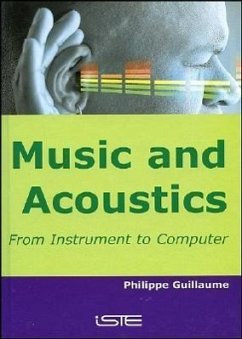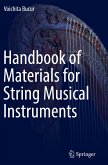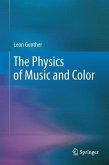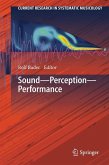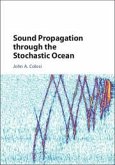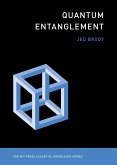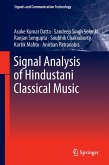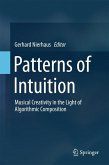Music and Acoustics
From Instrument to Computer
Herausgeber: Guillaume, Philippe
Music and Acoustics
From Instrument to Computer
Herausgeber: Guillaume, Philippe
- Gebundenes Buch
- Merkliste
- Auf die Merkliste
- Bewerten Bewerten
- Teilen
- Produkt teilen
- Produkterinnerung
- Produkterinnerung
How can a piano tuner obtain such high precision with no other measuring device than their own ears? How can a sequence of notes seem to rise continuously despite coming back periodically to the same notes? What are the possibilities and the limits of digital sound? These are a few examples of questions that are discussed in this book, which presents an overview on the nature of musical sounds, from their production by acoustic music instruments to synthesized sounds obtained with computers. The topics that are treated include sound propagation, Fourier and time-frequency analysis,…mehr
Andere Kunden interessierten sich auch für
![Handbook of Materials for String Musical Instruments Handbook of Materials for String Musical Instruments]() Voichita BucurHandbook of Materials for String Musical Instruments298,99 €
Voichita BucurHandbook of Materials for String Musical Instruments298,99 €![The Physics of Music and Color The Physics of Music and Color]() Leon GuntherThe Physics of Music and Color65,99 €
Leon GuntherThe Physics of Music and Color65,99 €![Sound - Perception - Performance Sound - Perception - Performance]() Sound - Perception - Performance112,99 €
Sound - Perception - Performance112,99 €![Sound Propagation Through the Stochastic Ocean Sound Propagation Through the Stochastic Ocean]() John A ColosiSound Propagation Through the Stochastic Ocean155,99 €
John A ColosiSound Propagation Through the Stochastic Ocean155,99 €![Quantum Entanglement Quantum Entanglement]() Jed BrodyQuantum Entanglement11,99 €
Jed BrodyQuantum Entanglement11,99 €![Signal Analysis of Hindustani Classical Music Signal Analysis of Hindustani Classical Music]() Asoke Kumar DattaSignal Analysis of Hindustani Classical Music104,99 €
Asoke Kumar DattaSignal Analysis of Hindustani Classical Music104,99 €![Patterns of Intuition Patterns of Intuition]() Patterns of Intuition90,99 €
Patterns of Intuition90,99 €-
-
-
How can a piano tuner obtain such high precision with no other measuring device than their own ears? How can a sequence of notes seem to rise continuously despite coming back periodically to the same notes? What are the possibilities and the limits of digital sound? These are a few examples of questions that are discussed in this book, which presents an overview on the nature of musical sounds, from their production by acoustic music instruments to synthesized sounds obtained with computers. The topics that are treated include sound propagation, Fourier and time-frequency analysis, psychoacoustics, analog and digital signal processing theory, computer science and MP3 sound compression, and of course... music!
Hinweis: Dieser Artikel kann nur an eine deutsche Lieferadresse ausgeliefert werden.
Hinweis: Dieser Artikel kann nur an eine deutsche Lieferadresse ausgeliefert werden.
Produktdetails
- Produktdetails
- Verlag: Wiley
- Seitenzahl: 199
- Erscheinungstermin: 1. April 2006
- Englisch
- Abmessung: 242mm x 163mm x 16mm
- Gewicht: 426g
- ISBN-13: 9781905209262
- ISBN-10: 1905209266
- Artikelnr.: 22432491
- Herstellerkennzeichnung
- Libri GmbH
- Europaallee 1
- 36244 Bad Hersfeld
- gpsr@libri.de
- Verlag: Wiley
- Seitenzahl: 199
- Erscheinungstermin: 1. April 2006
- Englisch
- Abmessung: 242mm x 163mm x 16mm
- Gewicht: 426g
- ISBN-13: 9781905209262
- ISBN-10: 1905209266
- Artikelnr.: 22432491
- Herstellerkennzeichnung
- Libri GmbH
- Europaallee 1
- 36244 Bad Hersfeld
- gpsr@libri.de
Philippe Guillaume is a Professor at INSA Toulouse, France where he teaches applied mathematics and musical acoustics. He is a researcher within the Laboratory of Mathematics for Industry and Physics in the same Institute. He worked for many years in his youth as a piano tuner for famous pianists.
Foreword 13
Chapter 1. Sounds 17
1.1. Sound propagation 17
1.1.1. A look at the physical models 17
1.1.1.1. Mass conservation 18
1.1.1.2. The Euler equation 20
1.1.1.3. The state equation 21
1.1.2. The wave equation 21
1.1.3. The Helmholtz equation 23
1.1.4. Sound intensity 25
1.2. Music theory interlude 27
1.2.1. Intervals, octave 28
1.2.2. Scientific pitch notation 28
1.2.3. Dividing the octave into twelve semitones 28
1.2.4. Diatonic scales 29
1.2.4.1. Major scale 29
1.2.4.2. Minor scales 30
1.3. Different types of sounds 31
1.3.1. Periodic sounds 32
1.3.1.1. Fourier series 34
1.3.2. Sounds with partials 35
1.3.3. Continuous spectrum sounds 36
1.3.4. Noise 37
1.4. Representation of sound 41
1.4.1. Time or frequency analysis, discrete Fourier transform 42
1.4.2. Time-frequency analysis, the spectrogram 44
1.5. Filtering 49
1.5.1. Discrete spectrum 49
1.5.1.1. Transfer function 50
1.5.1.2. Impulse response 51
1.5.2. Continuous spectrum 53
1.5.3. Ideal low-pass, band-pass and all-pass filters 53
1.6. Study problems 56
1.6.1. Normal reflection on a wall (*) 56
1.6.2. Comb filtering produced by a microphone located near a wall (**) 56
1.6.3. Summing intensities (***) 57
1.6.4. Intensity of a standing wave (**) 58
1.6.5. Sound of a siren (*) 58
1.7. Practical computer applications 58
1.7.1. First sound, vectors 58
1.7.2. Modifying the parameters: the command file 59
1.7.3. Creating more complex sounds: using functions 60
1.7.3.1. Noise and siren interlude 61
1.7.4. Analysis 61
1.7.4.1. Time analysis 62
1.7.4.2. Frequency analysis 62
1.7.4.3. Time-frequency analysis 63
1.7.5. Filtering 63
Chapter 2. Music Instruments 65
2.1. Strings 66
2.1.1. Free vibrations of a string 66
2.1.2. Beats, chords and consonance 69
2.2. Bars 72
2.2.1. Bar fixed at both ends 73
2.2.2. Bar clamped at one end 75
2.3. Membranes 77
2.4. Tubes 79
2.4.1. Pressure control 81
2.4.1.1. Response to a harmonic excitation 81
2.4.1.2. The resonance effect 82
2.4.1.3. Natural modes 84
2.4.1.4. The resulting sound 84
2.4.2. Speed control 85
2.4.2.1. Response to a harmonic excitation 85
2.4.2.2. Resonance and natural modes 87
2.4.2.3. Comments on phases 87
2.4.3. Tuning 88
2.5. Timbre of instruments 89
2.5.1. Nature of the spectrum 89
2.5.1.1. Harmonics or partials, the piano's inharmonicity 90
2.5.1.2. Richness in higher harmonics 91
2.5.1.3. Different harmonics distributions 93
2.5.1.4. The purpose of the resonator 94
2.5.2. Envelope of the sound 95
2.5.2.1. Calculation of the envelope 96
2.5.2.2. Using several envelopes 97
2.6. Study problems 98
2.6.1. Vibrations of a string (general case) (**) 98
2.6.2. Plucked string (*) 100
2.6.3. Bow drawn across a string (*) 100
2.6.4. String reduced to one degree of freedom (**) 101
2.6.5. Coupled string-bridge system and the remanence effect (***) 102
2.6.6. Calculation of the inharmonicity of a real string (***) 104
2.6.7. Coincidence frequency of a wave in a board (***) 106
2.6.8. Resonance of the bourdon (**) 107
2.6.9. Resonance of a cylindrical dual controlled tube (**) 108
2.6.10. Resonance of a conical tube (1) (**) 109
2.6.11. Resonance of a conical tube (2) (**) 110
2.7. Practical computer applications 110
2.7.1. Create your synthesizer 110
2.7.1.1. Write your instrument function 111
2.7.1.2. Add an envelope 111
2.7.1.3. And play your instrument 112
2.7.2. Modify the timbre of your instrument 112
2.7.3. Remanent sound 112
Chapter 3. Scales and Temperaments 115
3.1. The Pythagorean scale 116
3.2. The Zarlino scale 117
3.3. The tempered scales 118
3.3.1. Equal temperament 119
3.3.2. A historical temperament 119
3.3.3. Equal temperament with perfect fifth 120
3.3.4. The practice of tuners 120
3.3.5. The practice of musicians 121
3.4. A brief history of A4 121
3.5. Giving names to notes 122
3.6. Other examples of scales 123
3.7. Study problems 123
3.7.1. Frequencies of a few scales (***) 123
3.7.2. Beats of the fifths and the major thirds (*) 123
3.8. Practical computer applications 125
3.8.1. Building a few scales 125
3.8.2. Listening to beats 125
Chapter 4. Psychoacoustics 127
4.1. Sound intensity and loudness 127
4.1.1. The phon 128
4.1.2. The sone 129
4.2. The ear 130
4.3. Frequency and pitch 131
4.3.1. The mel scale 132
4.3.2. Composed sounds 133
4.3.2.1. Pitch of sounds composed of harmonics 133
4.3.2.2. Pitch of sounds composed of partials 133
4.3.3. An acoustic illusion 134
4.4. Frequency masking 136
4.5. Study problems 138
4.5.1. Equal-loudness levels (**) 138
4.5.2. Frequency masking (**) 138
4.5.3. Perpetually ascending sound (**) 138
4.6. Practical computer applications 138
4.6.1. Frequency masking 138
4.6.2. Perpetually ascending scale 138
Chapter 5. Digital Sound 141
5.1. Sampling 143
5.1.1. The Nyquist criterion and the Shannon theorem 145
5.1.1.1. Case of a sinusoidal signal 145
5.1.1.2. General case 147
5.1.1.3. Consequences 148
5.1.1.4. Theoretical impossibility 148
5.1.1.5. What happens if the Nyquist criterion is not met? 148
5.1.2. Quantization 152
5.1.2.1. Error due to quantization 153
5.1.3. Reconstruction of the sound signal 154
5.2. Audio compression 155
5.2.1. Psychoacoustic compression 155
5.2.2. Entropy compression 159
5.3. Digital filtering and the Z-transform 160
5.3.1. Digital filtering 160
5.3.2. The Z-transform 161
5.3.2.1. Definition 161
5.3.2.2. Effect of a delay 162
5.3.2.3. Filtering and Z-transform 163
5.4. Study problems 164
5.4.1. Nyquist criterion (*) 164
5.4.2. Aliasing of an ascending sound (*) 165
5.4.3. Another example of reconstruction (***) 165
5.4.4. Elementary filter bank (**) 166
5.5. Practical computer applications 167
5.5.1. Spectrum aliasing 167
5.5.2. Quantization noise 168
Chapter 6. Synthesis and Sound Effects 169
6.1. Synthesis of musical sounds 170
6.1.1. Subtractive synthesis 170
6.1.2. Additive synthesis 171
6.1.3. FM synthesis 171
6.1.4. Synthesis based on the use of sampled sounds 174
6.2. Time effects: echo and reverberation 175
6.2.1. Simple echo 175
6.2.2. Multiple echo 176
6.2.3. Reverberation 177
6.2.3.1. Using the impulse response 177
6.2.3.2. Using echoes and all-pass filters 178
6.3. Effects based on spectrum modification 179
6.3.1. The 'Wah-wah' effect 180
6.3.1.1. An example of a band-pass filter 180
6.3.2. AM or FM type sound effects 182
6.3.2.1. Vibrato 183
6.3.2.2. Leslie effect 184
6.4. Study problems 186
6.4.1. The Doppler effect (**) 186
6.4.2. FM and Chowning (***) 187
6.5. Practical computer applications 188
6.5.1. Sound synthesis 188
6.5.2. Chowning synthesis 188
6.5.3. Reverberation 189
6.5.4. Vibrato 189
6.5.5. The Leslie effect 189
Bibliography 191
Index 193
Chapter 1. Sounds 17
1.1. Sound propagation 17
1.1.1. A look at the physical models 17
1.1.1.1. Mass conservation 18
1.1.1.2. The Euler equation 20
1.1.1.3. The state equation 21
1.1.2. The wave equation 21
1.1.3. The Helmholtz equation 23
1.1.4. Sound intensity 25
1.2. Music theory interlude 27
1.2.1. Intervals, octave 28
1.2.2. Scientific pitch notation 28
1.2.3. Dividing the octave into twelve semitones 28
1.2.4. Diatonic scales 29
1.2.4.1. Major scale 29
1.2.4.2. Minor scales 30
1.3. Different types of sounds 31
1.3.1. Periodic sounds 32
1.3.1.1. Fourier series 34
1.3.2. Sounds with partials 35
1.3.3. Continuous spectrum sounds 36
1.3.4. Noise 37
1.4. Representation of sound 41
1.4.1. Time or frequency analysis, discrete Fourier transform 42
1.4.2. Time-frequency analysis, the spectrogram 44
1.5. Filtering 49
1.5.1. Discrete spectrum 49
1.5.1.1. Transfer function 50
1.5.1.2. Impulse response 51
1.5.2. Continuous spectrum 53
1.5.3. Ideal low-pass, band-pass and all-pass filters 53
1.6. Study problems 56
1.6.1. Normal reflection on a wall (*) 56
1.6.2. Comb filtering produced by a microphone located near a wall (**) 56
1.6.3. Summing intensities (***) 57
1.6.4. Intensity of a standing wave (**) 58
1.6.5. Sound of a siren (*) 58
1.7. Practical computer applications 58
1.7.1. First sound, vectors 58
1.7.2. Modifying the parameters: the command file 59
1.7.3. Creating more complex sounds: using functions 60
1.7.3.1. Noise and siren interlude 61
1.7.4. Analysis 61
1.7.4.1. Time analysis 62
1.7.4.2. Frequency analysis 62
1.7.4.3. Time-frequency analysis 63
1.7.5. Filtering 63
Chapter 2. Music Instruments 65
2.1. Strings 66
2.1.1. Free vibrations of a string 66
2.1.2. Beats, chords and consonance 69
2.2. Bars 72
2.2.1. Bar fixed at both ends 73
2.2.2. Bar clamped at one end 75
2.3. Membranes 77
2.4. Tubes 79
2.4.1. Pressure control 81
2.4.1.1. Response to a harmonic excitation 81
2.4.1.2. The resonance effect 82
2.4.1.3. Natural modes 84
2.4.1.4. The resulting sound 84
2.4.2. Speed control 85
2.4.2.1. Response to a harmonic excitation 85
2.4.2.2. Resonance and natural modes 87
2.4.2.3. Comments on phases 87
2.4.3. Tuning 88
2.5. Timbre of instruments 89
2.5.1. Nature of the spectrum 89
2.5.1.1. Harmonics or partials, the piano's inharmonicity 90
2.5.1.2. Richness in higher harmonics 91
2.5.1.3. Different harmonics distributions 93
2.5.1.4. The purpose of the resonator 94
2.5.2. Envelope of the sound 95
2.5.2.1. Calculation of the envelope 96
2.5.2.2. Using several envelopes 97
2.6. Study problems 98
2.6.1. Vibrations of a string (general case) (**) 98
2.6.2. Plucked string (*) 100
2.6.3. Bow drawn across a string (*) 100
2.6.4. String reduced to one degree of freedom (**) 101
2.6.5. Coupled string-bridge system and the remanence effect (***) 102
2.6.6. Calculation of the inharmonicity of a real string (***) 104
2.6.7. Coincidence frequency of a wave in a board (***) 106
2.6.8. Resonance of the bourdon (**) 107
2.6.9. Resonance of a cylindrical dual controlled tube (**) 108
2.6.10. Resonance of a conical tube (1) (**) 109
2.6.11. Resonance of a conical tube (2) (**) 110
2.7. Practical computer applications 110
2.7.1. Create your synthesizer 110
2.7.1.1. Write your instrument function 111
2.7.1.2. Add an envelope 111
2.7.1.3. And play your instrument 112
2.7.2. Modify the timbre of your instrument 112
2.7.3. Remanent sound 112
Chapter 3. Scales and Temperaments 115
3.1. The Pythagorean scale 116
3.2. The Zarlino scale 117
3.3. The tempered scales 118
3.3.1. Equal temperament 119
3.3.2. A historical temperament 119
3.3.3. Equal temperament with perfect fifth 120
3.3.4. The practice of tuners 120
3.3.5. The practice of musicians 121
3.4. A brief history of A4 121
3.5. Giving names to notes 122
3.6. Other examples of scales 123
3.7. Study problems 123
3.7.1. Frequencies of a few scales (***) 123
3.7.2. Beats of the fifths and the major thirds (*) 123
3.8. Practical computer applications 125
3.8.1. Building a few scales 125
3.8.2. Listening to beats 125
Chapter 4. Psychoacoustics 127
4.1. Sound intensity and loudness 127
4.1.1. The phon 128
4.1.2. The sone 129
4.2. The ear 130
4.3. Frequency and pitch 131
4.3.1. The mel scale 132
4.3.2. Composed sounds 133
4.3.2.1. Pitch of sounds composed of harmonics 133
4.3.2.2. Pitch of sounds composed of partials 133
4.3.3. An acoustic illusion 134
4.4. Frequency masking 136
4.5. Study problems 138
4.5.1. Equal-loudness levels (**) 138
4.5.2. Frequency masking (**) 138
4.5.3. Perpetually ascending sound (**) 138
4.6. Practical computer applications 138
4.6.1. Frequency masking 138
4.6.2. Perpetually ascending scale 138
Chapter 5. Digital Sound 141
5.1. Sampling 143
5.1.1. The Nyquist criterion and the Shannon theorem 145
5.1.1.1. Case of a sinusoidal signal 145
5.1.1.2. General case 147
5.1.1.3. Consequences 148
5.1.1.4. Theoretical impossibility 148
5.1.1.5. What happens if the Nyquist criterion is not met? 148
5.1.2. Quantization 152
5.1.2.1. Error due to quantization 153
5.1.3. Reconstruction of the sound signal 154
5.2. Audio compression 155
5.2.1. Psychoacoustic compression 155
5.2.2. Entropy compression 159
5.3. Digital filtering and the Z-transform 160
5.3.1. Digital filtering 160
5.3.2. The Z-transform 161
5.3.2.1. Definition 161
5.3.2.2. Effect of a delay 162
5.3.2.3. Filtering and Z-transform 163
5.4. Study problems 164
5.4.1. Nyquist criterion (*) 164
5.4.2. Aliasing of an ascending sound (*) 165
5.4.3. Another example of reconstruction (***) 165
5.4.4. Elementary filter bank (**) 166
5.5. Practical computer applications 167
5.5.1. Spectrum aliasing 167
5.5.2. Quantization noise 168
Chapter 6. Synthesis and Sound Effects 169
6.1. Synthesis of musical sounds 170
6.1.1. Subtractive synthesis 170
6.1.2. Additive synthesis 171
6.1.3. FM synthesis 171
6.1.4. Synthesis based on the use of sampled sounds 174
6.2. Time effects: echo and reverberation 175
6.2.1. Simple echo 175
6.2.2. Multiple echo 176
6.2.3. Reverberation 177
6.2.3.1. Using the impulse response 177
6.2.3.2. Using echoes and all-pass filters 178
6.3. Effects based on spectrum modification 179
6.3.1. The 'Wah-wah' effect 180
6.3.1.1. An example of a band-pass filter 180
6.3.2. AM or FM type sound effects 182
6.3.2.1. Vibrato 183
6.3.2.2. Leslie effect 184
6.4. Study problems 186
6.4.1. The Doppler effect (**) 186
6.4.2. FM and Chowning (***) 187
6.5. Practical computer applications 188
6.5.1. Sound synthesis 188
6.5.2. Chowning synthesis 188
6.5.3. Reverberation 189
6.5.4. Vibrato 189
6.5.5. The Leslie effect 189
Bibliography 191
Index 193
Foreword 13
Chapter 1. Sounds 17
1.1. Sound propagation 17
1.1.1. A look at the physical models 17
1.1.1.1. Mass conservation 18
1.1.1.2. The Euler equation 20
1.1.1.3. The state equation 21
1.1.2. The wave equation 21
1.1.3. The Helmholtz equation 23
1.1.4. Sound intensity 25
1.2. Music theory interlude 27
1.2.1. Intervals, octave 28
1.2.2. Scientific pitch notation 28
1.2.3. Dividing the octave into twelve semitones 28
1.2.4. Diatonic scales 29
1.2.4.1. Major scale 29
1.2.4.2. Minor scales 30
1.3. Different types of sounds 31
1.3.1. Periodic sounds 32
1.3.1.1. Fourier series 34
1.3.2. Sounds with partials 35
1.3.3. Continuous spectrum sounds 36
1.3.4. Noise 37
1.4. Representation of sound 41
1.4.1. Time or frequency analysis, discrete Fourier transform 42
1.4.2. Time-frequency analysis, the spectrogram 44
1.5. Filtering 49
1.5.1. Discrete spectrum 49
1.5.1.1. Transfer function 50
1.5.1.2. Impulse response 51
1.5.2. Continuous spectrum 53
1.5.3. Ideal low-pass, band-pass and all-pass filters 53
1.6. Study problems 56
1.6.1. Normal reflection on a wall (*) 56
1.6.2. Comb filtering produced by a microphone located near a wall (**) 56
1.6.3. Summing intensities (***) 57
1.6.4. Intensity of a standing wave (**) 58
1.6.5. Sound of a siren (*) 58
1.7. Practical computer applications 58
1.7.1. First sound, vectors 58
1.7.2. Modifying the parameters: the command file 59
1.7.3. Creating more complex sounds: using functions 60
1.7.3.1. Noise and siren interlude 61
1.7.4. Analysis 61
1.7.4.1. Time analysis 62
1.7.4.2. Frequency analysis 62
1.7.4.3. Time-frequency analysis 63
1.7.5. Filtering 63
Chapter 2. Music Instruments 65
2.1. Strings 66
2.1.1. Free vibrations of a string 66
2.1.2. Beats, chords and consonance 69
2.2. Bars 72
2.2.1. Bar fixed at both ends 73
2.2.2. Bar clamped at one end 75
2.3. Membranes 77
2.4. Tubes 79
2.4.1. Pressure control 81
2.4.1.1. Response to a harmonic excitation 81
2.4.1.2. The resonance effect 82
2.4.1.3. Natural modes 84
2.4.1.4. The resulting sound 84
2.4.2. Speed control 85
2.4.2.1. Response to a harmonic excitation 85
2.4.2.2. Resonance and natural modes 87
2.4.2.3. Comments on phases 87
2.4.3. Tuning 88
2.5. Timbre of instruments 89
2.5.1. Nature of the spectrum 89
2.5.1.1. Harmonics or partials, the piano's inharmonicity 90
2.5.1.2. Richness in higher harmonics 91
2.5.1.3. Different harmonics distributions 93
2.5.1.4. The purpose of the resonator 94
2.5.2. Envelope of the sound 95
2.5.2.1. Calculation of the envelope 96
2.5.2.2. Using several envelopes 97
2.6. Study problems 98
2.6.1. Vibrations of a string (general case) (**) 98
2.6.2. Plucked string (*) 100
2.6.3. Bow drawn across a string (*) 100
2.6.4. String reduced to one degree of freedom (**) 101
2.6.5. Coupled string-bridge system and the remanence effect (***) 102
2.6.6. Calculation of the inharmonicity of a real string (***) 104
2.6.7. Coincidence frequency of a wave in a board (***) 106
2.6.8. Resonance of the bourdon (**) 107
2.6.9. Resonance of a cylindrical dual controlled tube (**) 108
2.6.10. Resonance of a conical tube (1) (**) 109
2.6.11. Resonance of a conical tube (2) (**) 110
2.7. Practical computer applications 110
2.7.1. Create your synthesizer 110
2.7.1.1. Write your instrument function 111
2.7.1.2. Add an envelope 111
2.7.1.3. And play your instrument 112
2.7.2. Modify the timbre of your instrument 112
2.7.3. Remanent sound 112
Chapter 3. Scales and Temperaments 115
3.1. The Pythagorean scale 116
3.2. The Zarlino scale 117
3.3. The tempered scales 118
3.3.1. Equal temperament 119
3.3.2. A historical temperament 119
3.3.3. Equal temperament with perfect fifth 120
3.3.4. The practice of tuners 120
3.3.5. The practice of musicians 121
3.4. A brief history of A4 121
3.5. Giving names to notes 122
3.6. Other examples of scales 123
3.7. Study problems 123
3.7.1. Frequencies of a few scales (***) 123
3.7.2. Beats of the fifths and the major thirds (*) 123
3.8. Practical computer applications 125
3.8.1. Building a few scales 125
3.8.2. Listening to beats 125
Chapter 4. Psychoacoustics 127
4.1. Sound intensity and loudness 127
4.1.1. The phon 128
4.1.2. The sone 129
4.2. The ear 130
4.3. Frequency and pitch 131
4.3.1. The mel scale 132
4.3.2. Composed sounds 133
4.3.2.1. Pitch of sounds composed of harmonics 133
4.3.2.2. Pitch of sounds composed of partials 133
4.3.3. An acoustic illusion 134
4.4. Frequency masking 136
4.5. Study problems 138
4.5.1. Equal-loudness levels (**) 138
4.5.2. Frequency masking (**) 138
4.5.3. Perpetually ascending sound (**) 138
4.6. Practical computer applications 138
4.6.1. Frequency masking 138
4.6.2. Perpetually ascending scale 138
Chapter 5. Digital Sound 141
5.1. Sampling 143
5.1.1. The Nyquist criterion and the Shannon theorem 145
5.1.1.1. Case of a sinusoidal signal 145
5.1.1.2. General case 147
5.1.1.3. Consequences 148
5.1.1.4. Theoretical impossibility 148
5.1.1.5. What happens if the Nyquist criterion is not met? 148
5.1.2. Quantization 152
5.1.2.1. Error due to quantization 153
5.1.3. Reconstruction of the sound signal 154
5.2. Audio compression 155
5.2.1. Psychoacoustic compression 155
5.2.2. Entropy compression 159
5.3. Digital filtering and the Z-transform 160
5.3.1. Digital filtering 160
5.3.2. The Z-transform 161
5.3.2.1. Definition 161
5.3.2.2. Effect of a delay 162
5.3.2.3. Filtering and Z-transform 163
5.4. Study problems 164
5.4.1. Nyquist criterion (*) 164
5.4.2. Aliasing of an ascending sound (*) 165
5.4.3. Another example of reconstruction (***) 165
5.4.4. Elementary filter bank (**) 166
5.5. Practical computer applications 167
5.5.1. Spectrum aliasing 167
5.5.2. Quantization noise 168
Chapter 6. Synthesis and Sound Effects 169
6.1. Synthesis of musical sounds 170
6.1.1. Subtractive synthesis 170
6.1.2. Additive synthesis 171
6.1.3. FM synthesis 171
6.1.4. Synthesis based on the use of sampled sounds 174
6.2. Time effects: echo and reverberation 175
6.2.1. Simple echo 175
6.2.2. Multiple echo 176
6.2.3. Reverberation 177
6.2.3.1. Using the impulse response 177
6.2.3.2. Using echoes and all-pass filters 178
6.3. Effects based on spectrum modification 179
6.3.1. The 'Wah-wah' effect 180
6.3.1.1. An example of a band-pass filter 180
6.3.2. AM or FM type sound effects 182
6.3.2.1. Vibrato 183
6.3.2.2. Leslie effect 184
6.4. Study problems 186
6.4.1. The Doppler effect (**) 186
6.4.2. FM and Chowning (***) 187
6.5. Practical computer applications 188
6.5.1. Sound synthesis 188
6.5.2. Chowning synthesis 188
6.5.3. Reverberation 189
6.5.4. Vibrato 189
6.5.5. The Leslie effect 189
Bibliography 191
Index 193
Chapter 1. Sounds 17
1.1. Sound propagation 17
1.1.1. A look at the physical models 17
1.1.1.1. Mass conservation 18
1.1.1.2. The Euler equation 20
1.1.1.3. The state equation 21
1.1.2. The wave equation 21
1.1.3. The Helmholtz equation 23
1.1.4. Sound intensity 25
1.2. Music theory interlude 27
1.2.1. Intervals, octave 28
1.2.2. Scientific pitch notation 28
1.2.3. Dividing the octave into twelve semitones 28
1.2.4. Diatonic scales 29
1.2.4.1. Major scale 29
1.2.4.2. Minor scales 30
1.3. Different types of sounds 31
1.3.1. Periodic sounds 32
1.3.1.1. Fourier series 34
1.3.2. Sounds with partials 35
1.3.3. Continuous spectrum sounds 36
1.3.4. Noise 37
1.4. Representation of sound 41
1.4.1. Time or frequency analysis, discrete Fourier transform 42
1.4.2. Time-frequency analysis, the spectrogram 44
1.5. Filtering 49
1.5.1. Discrete spectrum 49
1.5.1.1. Transfer function 50
1.5.1.2. Impulse response 51
1.5.2. Continuous spectrum 53
1.5.3. Ideal low-pass, band-pass and all-pass filters 53
1.6. Study problems 56
1.6.1. Normal reflection on a wall (*) 56
1.6.2. Comb filtering produced by a microphone located near a wall (**) 56
1.6.3. Summing intensities (***) 57
1.6.4. Intensity of a standing wave (**) 58
1.6.5. Sound of a siren (*) 58
1.7. Practical computer applications 58
1.7.1. First sound, vectors 58
1.7.2. Modifying the parameters: the command file 59
1.7.3. Creating more complex sounds: using functions 60
1.7.3.1. Noise and siren interlude 61
1.7.4. Analysis 61
1.7.4.1. Time analysis 62
1.7.4.2. Frequency analysis 62
1.7.4.3. Time-frequency analysis 63
1.7.5. Filtering 63
Chapter 2. Music Instruments 65
2.1. Strings 66
2.1.1. Free vibrations of a string 66
2.1.2. Beats, chords and consonance 69
2.2. Bars 72
2.2.1. Bar fixed at both ends 73
2.2.2. Bar clamped at one end 75
2.3. Membranes 77
2.4. Tubes 79
2.4.1. Pressure control 81
2.4.1.1. Response to a harmonic excitation 81
2.4.1.2. The resonance effect 82
2.4.1.3. Natural modes 84
2.4.1.4. The resulting sound 84
2.4.2. Speed control 85
2.4.2.1. Response to a harmonic excitation 85
2.4.2.2. Resonance and natural modes 87
2.4.2.3. Comments on phases 87
2.4.3. Tuning 88
2.5. Timbre of instruments 89
2.5.1. Nature of the spectrum 89
2.5.1.1. Harmonics or partials, the piano's inharmonicity 90
2.5.1.2. Richness in higher harmonics 91
2.5.1.3. Different harmonics distributions 93
2.5.1.4. The purpose of the resonator 94
2.5.2. Envelope of the sound 95
2.5.2.1. Calculation of the envelope 96
2.5.2.2. Using several envelopes 97
2.6. Study problems 98
2.6.1. Vibrations of a string (general case) (**) 98
2.6.2. Plucked string (*) 100
2.6.3. Bow drawn across a string (*) 100
2.6.4. String reduced to one degree of freedom (**) 101
2.6.5. Coupled string-bridge system and the remanence effect (***) 102
2.6.6. Calculation of the inharmonicity of a real string (***) 104
2.6.7. Coincidence frequency of a wave in a board (***) 106
2.6.8. Resonance of the bourdon (**) 107
2.6.9. Resonance of a cylindrical dual controlled tube (**) 108
2.6.10. Resonance of a conical tube (1) (**) 109
2.6.11. Resonance of a conical tube (2) (**) 110
2.7. Practical computer applications 110
2.7.1. Create your synthesizer 110
2.7.1.1. Write your instrument function 111
2.7.1.2. Add an envelope 111
2.7.1.3. And play your instrument 112
2.7.2. Modify the timbre of your instrument 112
2.7.3. Remanent sound 112
Chapter 3. Scales and Temperaments 115
3.1. The Pythagorean scale 116
3.2. The Zarlino scale 117
3.3. The tempered scales 118
3.3.1. Equal temperament 119
3.3.2. A historical temperament 119
3.3.3. Equal temperament with perfect fifth 120
3.3.4. The practice of tuners 120
3.3.5. The practice of musicians 121
3.4. A brief history of A4 121
3.5. Giving names to notes 122
3.6. Other examples of scales 123
3.7. Study problems 123
3.7.1. Frequencies of a few scales (***) 123
3.7.2. Beats of the fifths and the major thirds (*) 123
3.8. Practical computer applications 125
3.8.1. Building a few scales 125
3.8.2. Listening to beats 125
Chapter 4. Psychoacoustics 127
4.1. Sound intensity and loudness 127
4.1.1. The phon 128
4.1.2. The sone 129
4.2. The ear 130
4.3. Frequency and pitch 131
4.3.1. The mel scale 132
4.3.2. Composed sounds 133
4.3.2.1. Pitch of sounds composed of harmonics 133
4.3.2.2. Pitch of sounds composed of partials 133
4.3.3. An acoustic illusion 134
4.4. Frequency masking 136
4.5. Study problems 138
4.5.1. Equal-loudness levels (**) 138
4.5.2. Frequency masking (**) 138
4.5.3. Perpetually ascending sound (**) 138
4.6. Practical computer applications 138
4.6.1. Frequency masking 138
4.6.2. Perpetually ascending scale 138
Chapter 5. Digital Sound 141
5.1. Sampling 143
5.1.1. The Nyquist criterion and the Shannon theorem 145
5.1.1.1. Case of a sinusoidal signal 145
5.1.1.2. General case 147
5.1.1.3. Consequences 148
5.1.1.4. Theoretical impossibility 148
5.1.1.5. What happens if the Nyquist criterion is not met? 148
5.1.2. Quantization 152
5.1.2.1. Error due to quantization 153
5.1.3. Reconstruction of the sound signal 154
5.2. Audio compression 155
5.2.1. Psychoacoustic compression 155
5.2.2. Entropy compression 159
5.3. Digital filtering and the Z-transform 160
5.3.1. Digital filtering 160
5.3.2. The Z-transform 161
5.3.2.1. Definition 161
5.3.2.2. Effect of a delay 162
5.3.2.3. Filtering and Z-transform 163
5.4. Study problems 164
5.4.1. Nyquist criterion (*) 164
5.4.2. Aliasing of an ascending sound (*) 165
5.4.3. Another example of reconstruction (***) 165
5.4.4. Elementary filter bank (**) 166
5.5. Practical computer applications 167
5.5.1. Spectrum aliasing 167
5.5.2. Quantization noise 168
Chapter 6. Synthesis and Sound Effects 169
6.1. Synthesis of musical sounds 170
6.1.1. Subtractive synthesis 170
6.1.2. Additive synthesis 171
6.1.3. FM synthesis 171
6.1.4. Synthesis based on the use of sampled sounds 174
6.2. Time effects: echo and reverberation 175
6.2.1. Simple echo 175
6.2.2. Multiple echo 176
6.2.3. Reverberation 177
6.2.3.1. Using the impulse response 177
6.2.3.2. Using echoes and all-pass filters 178
6.3. Effects based on spectrum modification 179
6.3.1. The 'Wah-wah' effect 180
6.3.1.1. An example of a band-pass filter 180
6.3.2. AM or FM type sound effects 182
6.3.2.1. Vibrato 183
6.3.2.2. Leslie effect 184
6.4. Study problems 186
6.4.1. The Doppler effect (**) 186
6.4.2. FM and Chowning (***) 187
6.5. Practical computer applications 188
6.5.1. Sound synthesis 188
6.5.2. Chowning synthesis 188
6.5.3. Reverberation 189
6.5.4. Vibrato 189
6.5.5. The Leslie effect 189
Bibliography 191
Index 193

